Conversion of non-Islamic places of worship into mosques
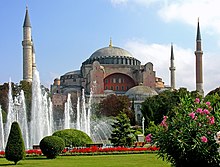
| Part of a series on |
| Islam |
|---|
 |
| Part of a series on |
| Islamization |
|---|
 |
The conversion of non-Islamic places of worship into mosques occurred during the life of Muhammad[citation needed] and continued during subsequent Islamic conquests and invasions and under historical Muslim rule.[citation needed] Hindu temples, Jain Temples, churches, synagogues, and Zoroastrian fire temples have been converted into mosques.
Several such mosques in the areas of former Muslim rule have since been reconverted or have become museums, including the Parthenon in Greece and numerous mosques in Spain, such as Mosque–Cathedral of Córdoba. Conversion of non-Islamic buildings into mosques influenced distinctive regional styles of Islamic architecture.
Qur'anic holy sites
[edit]Mecca
[edit]Before Muhammad, the Kaaba and Mecca (referred to as Bakkah in the Quran), were revered as a sacred sanctuary and were sites of pilgrimage.[1] During Muhammad's lifetime (AD 570–632), his tribe, the Quraysh, was in charge of the Kaʿaba, at that time a shrine containing hundreds of idols representing Arabian tribal gods and other religious figures. Muhammad earned the enmity of his tribe by preaching the new religion of Islam. Early Muslims practiced, or attempted to practice, their rituals by the Ka'aba alongside polytheists, until they eventually left Mecca, driven out by escalating persecution. The aborted first pilgrimage, which was prevented by the Quraysh, who promised to allow it the following year in the Hudaybiyah treaty, did not also entail the prevention of continuing practices by polytheists. However, before the second pilgrimage season, allies of the Quraysh violated the treaty, allowing the Muslims to return as conquerors rather than guests. Henceforth, the Kaʿaba was to be dedicated to the worship of the one God alone, and the idols were destroyed. The Black Stone (al-Hajar-ul-Aswad) at the Kaʿaba was a special object of veneration at the site. According to some traditions the text of seven or ten especially honoured poems were suspended around the Kaʿaba.[2]
Jerusalem
[edit]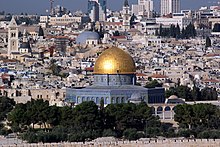
Upon the capture of Jerusalem, it is commonly reported that Umar refused to pray in the Church of the Holy Sepulchre in spite of a treaty.[3][better source needed] The architecturally similar Dome of the Rock was built on the Temple Mount, which was a destroyed site of the holiest Jewish temple, destroyed by the Romans in AD 70 and with consistent Jewish presence in Jerusalem has always been a site of religious prayer for Jews.[4] Umar initially built there a small prayer house which laid the foundation for the later construction of the Al-Aqsa Mosque by the Umayyads.[5]
Conversion of church buildings
[edit]Europe
[edit]Albania
[edit]- The Catholic church of Saint Nicholas (Shën Nikollë) was turned into a mosque. After being destroyed in the Communist 1967 anti-religious campaign, the site was turned into an open air mausoleum.
- The church of St Stephen in Shkodër was converted into a mosque in 1479 after the city was conquered by the Ottomans.
Bosnia and Herzegovina
[edit]
The Fethija Mosque (since 1592) of Bihać was a Catholic church devoted to Saint Anthony of Padua (1266).[6]
Cyprus
[edit]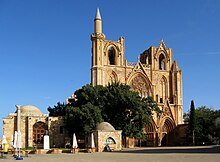
Following the Ottoman conquest of Cyprus, a number of churches (especially the Catholic ones) were converted into mosques. A relatively significant surge in church-to-mosque conversion followed the 1974 Turkish Invasion of Cyprus. Many of the Orthodox churches in Northern Cyprus have been converted, and many are still in the process of becoming mosques[citation needed].
Greece
[edit]
Numerous orthodox churches were converted to mosques during the Ottoman period in Greece. After the Greek War of Independence, many of them were later reconverted into churches. Among them:
- The Church of the Acheiropoietos (Eski Mosque), the Church of Hosios David (Suluca or Murad Mosque), the Church of Prophet Elijah (Saraylı Mosque), the Church of Saint Catherine (Yakup Pasha Mosque), the Church of Saint Panteleimon (Ishakiye Mosque), the Church of Holy Apostles (Soğuksu Mosque), the Church of Hagios Demetrios (Kasımiye Mosque), the Church of Hagia Sophia (Ayasofya Mosque), the Church of Panagia Chalkeon (Kazancilar Mosque), the church of Taxiarches (İki Şerefiye Mosque), the Rotonda of Galerius (Mosque of Suleyman Hortaji Effendi) in Thessaloniki.
- The Cathedral church of Veria (Hünkar Mosque) and the Church of Saint Paul in Veria (Medrese Mosque).
- The Church of Saint John in Ioannina, destroyed by the Ottomans and the Aslan Pasha Mosque was built in its place.
- The Theotokos Kosmosoteira monastery in Feres was converted into a mosque in the mid-14th century.
- The original Pantocrator (Kursum Mosque) church building in Patras.
- The gothic-style Panagia tou Kastrou (Enderun Mosque), the Holy Trinity church in Knights Avenue (Khan Zade Mosque) in Rhodes.
- The Brontochion Monastery, the Hagia Sophia (Ayasofya Mosque), and Panagia Hodegetria (Fethiye Mosque) churches in Laconia.
- The Hagia Sophia (Bey Mosque) in Drama.
- Parthenon in Athens: Some time before the close of the fifteenth century, the Parthenon became a mosque. Before that the Parthenon had been a Greek Orthodox church. Much of it was destroyed in a 1687 explosion, and a smaller mosque was erected within the ruins in 1715; this mosque was demolished in 1843. See Parthenon mosque.
- The Fethiye Mosque in Athens was built on top of a Byzantine basilica. It is currently an exhibition centre.
- The church of Saint Nicholas (Hünkar Mosque) was originally a Roman Catholic church before it was converted into a mosque.

Hungary
[edit]Following the Ottoman conquest of the Kingdom of Hungary, a number of churches were converted into mosques. Those that survived the era of Ottoman rule, were later reconverted into churches after the Great Turkish War.
- Church of Our Lady of Buda, converted into Eski Djami immediately after the capture of Buda in 1541, reconverted in 1686.
- Church of Mary Magdalene, Buda, converted into Fethiye Djami c. 1602, reconverted in 1686.[citation needed]
- The Franciscan Church of St John the Baptist in Buda, converted into Pasha Djami, destroyed in 1686.[citation needed]
Spain
[edit]A Catholic church dedicated to Saint Vincent of Lérins, was built by the Visigoths in Córdoba; during the reign of Abd al-Rahman I, it was converted into a mosque.[7][8][9] In the time of the Reconquista, Christian rule was reestablished and the building became a church once again, the Cathedral of Our Lady of the Assumption.[7][8][9]
Ukraine
[edit]After the Ottomans conquered Mangup, the capital of Principality of Theodoro, a prayer for the Sultan recited in one of the churches which converted into a mosque, and according to Turkish authors "the house of the infidel became the house of Islam."[10][better source needed]
Middle East and North Africa
[edit]Iraq
[edit]The Islamic State converted a number of churches into mosques after they occupied Mosul in 2014. The churches were restored to their original function after Mosul was liberated in 2017.[11]
- Chaldean Church of St. Joseph in Mosul, Iraq
Israel and Palestinian territories
[edit]
- Cave of the Patriarchs [citation needed]
- Tombs of Nathan and Gad in Halhoul, transformed into Mosque of Prophet Yunus.[13][14]
The Herodian shrine of the Cave of the Patriarchs in Hebron, the second most holy site in Judaism,[15] was converted into a church during the Crusades before being turned into a mosque in 1266 and henceforth banned to Jews and Christians.[16] Part of it was restored as a synagogue by Israel after 1967.[17] Other sites in Hebron have undergone Islamification. The Tomb of Jesse and Ruth became the Church of the Forty Martyrs,[18] which then became the Tomb of Isai and later Deir Al Arba'een.[19]
Lebanon
[edit]- Al-Omari Grand Mosque in Beirut, Lebanon; built as the Church of St. John the Baptist by the Knights Hospitaller; converted to mosque in 1291.[citation needed]
Morocco
[edit]- Grand Mosque of Tangier; built on a formerly Roman pagan, and then Roman Christian, site.[20][21]
Syria
[edit]
- The Umayyad Mosque in Damascus; built on the site of a Christian basilica dedicated to John the Baptist (Yahya), which was earlier, a Roman Pagan temple of Jupiter.
- Great Mosque of al-Nuri in Homs; initially a pagan temple for the sun god ("El-Gabal"), then converted into a church dedicated to Saint John the Baptist [citation needed]
- Great Mosque of Hama; a temple to worship the Roman god Jupiter, later it became a church during the Byzantine era[citation needed]
- Great Mosque of Aleppo; the agora of the Hellenistic period, which later became the garden for the Cathedral of Saint Helena[citation needed]
- The mosque of Job in Al-Shaykh Saad, Syria, was previously a church of Job.[22]
Turkey
[edit]Istanbul
[edit]Hagia Sophia
[edit]Following the Ottoman conquest of Anatolia, virtually all of the churches of Istanbul were converted into mosques except the Church of Saint Mary of the Mongols.[23]
- Hagia Sophia (from the Greek: Ἁγία Σοφία, "Holy Wisdom"; Latin: Sancta Sophia or Sancta Sapientia; Turkish: Ayasofya) was the cathedral of Constantinople in the state church of the Roman Empire and the seat of the Eastern Orthodox Church's Patriarchate. After 1453 it became a mosque, and since 1931 it has been a museum in Istanbul, Turkey. From the date of its dedication in 360 until 1453, it served as the Orthodox cathedral of the imperial capital, except between 1204 and 1261, when it became the Roman Catholic cathedral under the Latin Patriarch of Constantinople of the Western Crusader-established Latin Empire. In 1453, Constantinople was conquered by the Ottoman Turks under Sultan Mehmed II, who subsequently ordered the building converted into a mosque.[24] The bells, altar, iconostasis, ambo and sacrificial vessels were removed and many of the mosaics were plastered over. Islamic features – such as the mihrab, minbar, and four minarets – were added while in the possession of the Ottomans. The building was a mosque from 29 May 1453 until 1931, when it was secularised. It was opened as a museum on 1 February 1935.[25] On 10 July 2020, the decision of the Council of Ministers to transform it into a museum was canceled by Council of State and the Turkish President Erdoğan signed a decree annulling the Hagia Sophia's museum status, reverting it to a mosque.[26][27][28]
Other churches
[edit]- The Church of the Holy Apostles became the cathedral church and seat of the patriarchate for three years after the Fall of Constantinople, as Hagia Sophia became the city's Jama masjid. The Justinianic church was already in disrepair and in 1461 it was demolished and the Fatih Mosque was erected in its place.
- The Church of the Pantocrator, a church favoured for imperial burials in the latter Byzantine Empire, became the Zeyrek Mosque.
- The Church of SS Sergius and Bacchus, a church built by Justinian I, became a mosque dubbed the Little Hagia Sophia.
- The Church of Saint Andrew in Krisei, became the Koca Mustafa Pasha Mosque.
- The Church of Saint Thekla of the Palace of Blachernae, became the Atik Mustafa Pasha Mosque.
- The nunnery of Saint Theodosia, became the Gül Mosque.
- The Chora Church became the Kariye Mosque.
- The Monastery of Stoudios became the İmrahor Mosque.
- The Church of Saint John the Forerunner by-the-Dome became the Hirami Ahmet Pasha Mosque.
- The Church of Myrelaion became the Bodrum Mosque.
- The Catholic Church of Saint Paul became the Arap Mosque.
- The Lips Monastery became the Fenari Isa Mosque.
- The Monastery of Christ Pantepoptes became the Eski Imaret Mosque.
- The Church of Theotokos Kyriotissa became the Kalenderhane Mosque.
- The Church of Hagios Theodoros at Vefa became the Church-Mosque of Vefa.
- The Monastery of Manuel became the Kefeli Mosque.
- The Monastery of Gastria became the Sancaktar Hayrettin Mosque.
- The Church of Saint Mary of Constantinople became the Odalar Mosque.
- The Pammakaristos Church became the Fethiye Mosque.
- The Toklu Dede Mosque was an Eastern Orthodox church of unknown dedication.
- The monastery of the Holy Martyrs Menodora, Metrodora, and Nymphodora became the Manastır Mosque.
- Chora Church in Istanbul (2019)[29]
Rest of Turkey
[edit]
Elsewhere in Turkey numerous churches were converted into mosques, including:
Orthodox
[edit]- Hagia Sophia Church in Nicaea (İznik)[30]
- Hagia Sophia Church in Trebizond (Trabzon)
- Panagia Chrysokephalos Church, became the Fatih Mosque in Trabzon (Trabzon)
- Nakip Mosque was a Byzantine church. (Trabzon)
- Hagios Eugenios Church, became the New Friday Mosque (Trabzon)
- Saint Paul Cathedral, became the Tarsus Old Mosque (Tarsus)
- Church of Virgin Mary, became the Kesik Minare (Antalya)
- Church of Christ and Saint Stephen, became the Fatih Mosque in Tirilye (Tirilye)
- Hagia Sophia church in Enez[31]
Armenian Apostolic
[edit]Hundreds of Armenian Churches were converted into Mosques in Turkey and Azerbaijan[citation needed].
- Cathedral of Kars
- Cathedral of Ani
- Liberation Mosque, ex St Mary's Church Cathedral, Gaziantep
Conversion of Hindu temples
[edit]| Temple Name | Mosque Name | Images | City | Country | Ruler | Notes | Current Status |
|---|---|---|---|---|---|---|---|
| Kashi Vishwanath Temple | Gyanvapi Mosque | 
|
Varanasi, UP | India | Aurangzeb | The temple was demolished under the orders of Aurangzeb, who then constructed the Gyanvapi Mosque atop the original Hindu temple. The demolition was motivated by the rebellion of local zamindars (landowners) associated with the temple.[32] The demolition was intended as a warning to the anti-Mughal factions and Hindu religious leaders in the city.[33] | Mosque; temple reconstructed adjacent to Mosque |
| Keshavdeva Temple | Shahi Edgah | 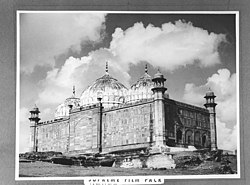
|
Mathura, UP | India | Aurangzeb attacked Mathura, destroyed the Keshavdeva Temple in 1670 and built the Shahi Eidgah in its place.[34][35] | Mosque; temple reconstructed adjacent to Mosque | |
| Bindu Madhav Temple | Alamgir Mosque | 
|
Varanasi, U.P. | India | The Alamgir Mosque in Varanasi was constructed by Mughal Emperor Aurnagzeb built atop the ancient 100 ft high Bindu Madhav (Nand Madho) Temple after its destruction in 1682.[36] | Mosque | |
| Atala Devi Temple | Atala Mosque |  |
Jaunpur, Uttar Pradesh | India | Firuz Shah Tughlaq | Firuz Shah Tughlaq destroyed the Atala Devi temple in 1377 and built the Atala Mosque over it.[37] | Mosque |
| Somnath Temple | 
|
Veraval, Gujarat | India | Mahmud of Ghazni, Alauddin Khalji, Muzaffar Shah I, Mahmud Begada, Aurangzeb | The temple was attacked, destroyed and rebuilt multiple times and was converted into an Islamic Mosque in the 19th century.[38] | Temple rebuilt | |
| Jain and Saraswati Temple | Adhai Din Ka Jhonpra | 
|
Ajmer, Rajasthan | India | Qutb ud-Din Aibak | The original building was partially destroyed and converted into a mosque by Qutb ud-Din Aibak of Delhi in the late 12th century.[39] Iltutmish further built the mosque in AD 1213.[40] | Mosque |
| Rudra Mahalaya Temple | Jami Mosque | 
|
Siddhpur, Gujarat | India | Ahmad Shah I | The temple was dismantled during the siege of the city by Ahmed Shah I (1410–1444) of Muzaffarid dynasty; parts of it were reused in setting up a new congregational mosque.[41] | Ruined, partly converted into Mosque |
Conversion of synagogues
[edit]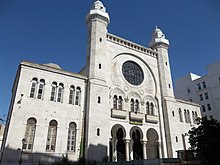
North Africa
[edit]Algeria
[edit]- Great Synagogue of Algiers, now Ben Farès Mosque
- Great Synagogue of Oran, now Abdellah Ben Salem Mosque
Europe
[edit]France
[edit]- Or Thora Synagogue of Marseille, built in the 1960s by Jews from Algeria, was turned into a mosque in 2016 after being bought by a conservative Muslim organization, the al-Badr organization.[43][44]
The Netherlands
[edit]- The Ashkenazi synagogue on Wagenstraat street of The Hague, built in 1844, became the Aqsa Mosque in 1981. The synagogue had been sold to the city by the Jewish community in 1976, on the grounds that it would not be converted into a church. In 1979 Turkish Muslim residents occupied the abandoned building and demanded it be turned into a mosque, citing alleged construction safety concerns with their usual mosque.[45] The synagogue was conceded to the Muslim community three years later.[46][47]
Influence on Islamic architecture
[edit]The conversion of non-Islamic religious buildings into mosques during the first centuries of Islam played a major role in the development of Islamic architectural styles. Distinct regional styles of mosque design, which have come to be known by such names as Arab, Persian, Andalusian, and others, commonly reflected the external and internal stylistic elements of churches and other temples characteristic for that region.[48]
See also
[edit]References
[edit]- ^ Britannica 2002 Deluxe Edition CD-ROM, "Ka'bah."
- ^ Amnon Shiloah (2001). Music in the World of Islam: A Socio-Cultural Study. Wayne State University Press. p. 4. ISBN 9780814329702.
- ^ Adrian Fortescue, "The Orthodox Eastern Church", Gorgias Press LLC, 1 December 2001, pg. 28 ISBN 0-9715986-1-4
- ^ Orlin, Eric (19 November 2015). Routledge Encyclopedia of Ancient Mediterranean Religions. ISBN 9781134625598. Retrieved 7 May 2016.
- ^ Le Strange, Guy (1890). Palestine Under the Moslems. p. 10.
It seems probable, also, that this latter Khalif, when he began to rebuild the Aksa, made use of the materials which lay to hand in the ruins of the great St. Mary Church of Justinian, which must originally have stood on the site, approximately, on which the Aksa Mosque was afterwards raised.
- ^ https://www.inyourpocket.com/bihac/Fethija-Mosque_53865v
- ^ a b Christys, Ann (2017). "The meaning of topography in Umayyad Cordoba". In Lester, Anne E. (ed.). Cities, Texts and Social Networks, 400–1500. Routledge.
It is a commonplace of the history of Córdoba that in their early years in the city, the Muslims shared with the Christians the church of S. Vicente, until ʿAbd al-Raḥmān I bought the Christians out and used the site to build the Great Mosque. It was a pivotal moment in the history of Córdoba, which later historians may have emphasised by drawing a parallel between Córdoba and another Umayyad capital, Damascus. The first reference to the Muslims' sharing the church was by Ibn Idhārī in the fourteenth century, citing the tenth-century historian al-Rāzī. It could be a version of a similar story referring to the Great Mosque in Damascus, which may itself have been written long after the Mosque was built. It is a story that meant something in the tenth-century context, a clear statement of the Muslim appropriation of Visigothic Córdoba.
- ^ a b Guia, Aitana (1 July 2014). The Muslim Struggle for Civil Rights in Spain, 1985–2010: Promoting Democracy Through Islamic Engagement. Sussex Academic Press. p. 137. ISBN 978-1-84519581-6.
It was originally a small temple of Christian Visigoth origin. Under Umayyad reign in Spain (711–1031 CE), it was expanded and made into a mosque, which it would remain for eight centuries. During the Christian reconquest of Al-Andalus, Christians captured the mosque and consecrated it as a Catholic church.
- ^ a b Armstrong, Ian (2013). Spain and Portugal. Avalon Travel Publishing. ISBN 978-1-61237031-6.
On this site originally stood the Visigoths' church of San Vicente, but when the Moors came to town in 758 CE they knocked it down and constructed a mosque in its place. When Córdoba fell once again to the Christians, King Ferdinand II and his successors set about Christianizing the structure, most dramatically adding the bright pearly white Renaissance nave where mass is held every morning.
- ^ Vasiliev, Alexander A. (1936). The Goths in the Crimea. Cambridge, MA: The Mediaeval Academy of America. p. 259.
- ^ "Iraq: Daesh have robbed and demolished every church". Independent Catholic News. 6 March 2018. Archived from the original on 20 March 2018. Retrieved 20 March 2018.
- ^ Tristram, Henry Baker (1865). The land of Israel : a journal of travels in Palestine, undertaken with special reference to its physical character. London: London Society for Promoting Christian Knowledge. p. 394.
The design is unique and patriarchal in its magnificent simplicity. One can scarcely tolerate the theory of some architectural writers, that this enclosure is of a period later than the Jewish. It would have been strange if any of the Herodian princes should here alone have raised, at enormous cost, a building utterly differing from the countless products of their architectural passion and Roman taste with which the land is strewn.
- ^ "For first time in 18 years, Jews pray at biblical tombs in Palestinian village". Times of Israel. AFP. Retrieved 20 July 2020.
- ^ Adler, Elkan Nathan (4 April 2014). Jewish Travellers. Routledge. p. 135. ISBN 978-1-134-28606-5.
"From there we reached Halhul, a place mentioned by Joshua. Here there are a certain number of Jews. They take travelers to see an ancient sepulchral monument attributed to Gad the Seer." — Isaac ben Joseph ibn Cehlo, 1334
- ^ Johnson, Paul (14 September 1988). A History of the Jews. Harper Collins. pp. 3–5. ISBN 978-0-06-091533-9.
- ^ Tristram, Henry Baker (1865). The land of Israel: a journal of travels in Palestine, undertaken with special reference to its physical character. London: Society for Promoting Christian Knowledge. pp. 390–396.
- ^ Goren, Shlomo (2016). With Might and Strength: An Autobiography. Maggid. ISBN 978-1592644094.
- ^ Pringle, Denys (1993). The Churches of the Crusader Kingdom of Jerusalem: A Corpus: Volume 2, L-Z (excluding Tyre). Cambridge University Press. ISBN 978-0-521-39037-8.
- ^ Sharon, Moshe. Corpus Inscriptionum Arabicarum Palaestinae, Volume Five: H-I. ISBN 9004250972.
- ^ Morocco. Dorling Kindersley Eyewitness Travel Guides. 2006. p. 133.
- ^ "Great Mosque (Tangier)". Archnet. Retrieved 31 December 2019.
- ^ Hillenbrand, R. "Masdjid. I. In the central Islamic lands". In P.J. Bearman; Th. Bianquis; C.E. Bosworth; E. van Donzel; W.P. Heinrichs (eds.). Encyclopaedia of Islam Online. Brill Academic Publishers. ISSN 1573-3912.
- ^ Mamboury (1953), p. 221.
- ^ "Archnet". Archived from the original on 5 January 2009. Retrieved 13 February 2009.
- ^ Magdalino, Paul; et al. "Istanbul: Buildings, Hagia Sophia". Grove Art Online. Archived from the original on 10 December 2010. Retrieved 28 February 2010.
- ^ "Ayasofya'yı camiden müzeye dönüştüren Bakanlar Kurulu kararı iptal edildi".
- ^ "Hagia Sophia: Turkey turns iconic Istanbul museum into mosque". BBC. 10 July 2020. Retrieved 10 July 2020.
- ^ Calian, Florin George (25 March 2021). "Opinion | The Hagia Sophia and Turkey's Neo-Ottomanism". The Armenian Weekly. Retrieved 7 January 2024.
- ^ YACKLEY, AYLA JEAN (2 July 2020). "From museum to mosque? Turkish court to rule on Hagia Sophia's fate". politico.eu. Retrieved 2 July 2020.
- ^ Letsch, Constanze (2 December 2011). "Turkey: Mystery Surrounds Decision to Turn Byzantine Church Museum into a Mosque". eurasianet.org. Retrieved 2 December 2011.
- ^ "Historic Hagia Sophia in a Turkish province to be re-opened as mosque". Hürriyet Daily News.
- ^ Truschke, Audrey (16 May 2017). Aurangzeb: The Life and Legacy of India's Most Controversial King. Stanford University Press. ISBN 9781503602595.
- ^ Catherine B. Asher (24 September 1992). Architecture of Mughal India. Cambridge University Press. pp. 278–279. ISBN 978-0-521-26728-1.
- ^ Audrey Truschke (1 February 2018). Aurangzeb: The Man and the Myth. Penguin Random House India Private Limited. pp. 95–96. ISBN 978-0-14-343967-7.
- ^ A. W. Entwistle (1 January 1987). Braj: Centre of Krishna pilgrimage. E. Forsten. pp. 125, 319–320. ISBN 9789069800165.
- ^ Rastogi, Saurabh (27 March 2018). "Alamgir Mosque - Lost Vishnu Temple of Varanasi". Varanasi Guru. Retrieved 31 March 2024.
- ^ Roshen Dalal (2010). The Religions of India. Penguin Books Limited. p. 448. ISBN 9788184753967.
- ^ Shokoohy, Mehrdad (2012). "The Legacy of Islam in Somnath". Bulletin of the School of Oriental and African Studies, University of London. 75 (2): 305. doi:10.1017/S0041977X12000493. JSTOR 23259581.
- ^ K.D.L. Khan (2 September 2007). "Ajmer's Adhai Din Ka Jhonpra". The Tribune Spectrum. Chandigarh.
- ^ "Adhai Din Ka Jhonpra". Archaeological Survey of India. Retrieved 22 January 2016.
- ^ Patel, Alka (2004). "Architectural Histories Entwined: The Rudra-Mahalaya/Congregational Mosque of Siddhpur, Gujarat". Journal of the Society of Architectural Historians. 63 (2): 144–163. doi:10.2307/4127950. JSTOR 4127950.
- ^ "Great Synagogue at Oran, Algeria | Archive | Diarna.org". Diarna. Retrieved 22 January 2024.
- ^ "À Marseille, une synagogue va être transformée en mosquée". La Croix (in French). 27 April 2016. ISSN 0242-6056. Retrieved 22 January 2024.
- ^ "The Marseille synagogue that is becoming a mosque". BBC News. 6 May 2016. Retrieved 22 January 2024.
- ^ "Moslems Want to Retain Synagogue". Jewish Telegraphic Agency. 20 March 2015. Retrieved 22 January 2024.
- ^ "The Hague". Jewish Cultural Quarter. Retrieved 22 January 2024.
- ^ "Wagenstraat Synagogue in Den Haag". Religiana. Retrieved 22 January 2024.
- ^ Patrick D. Gaffney (2004). "Masjid". In Richard C. Martin (ed.). Encyclopedia of Islam and the Muslim World. MacMillan Reference.
External links
[edit] Quotations related to Conversion of non-Islamic places of worship into mosques at Wikiquote
Quotations related to Conversion of non-Islamic places of worship into mosques at Wikiquote
